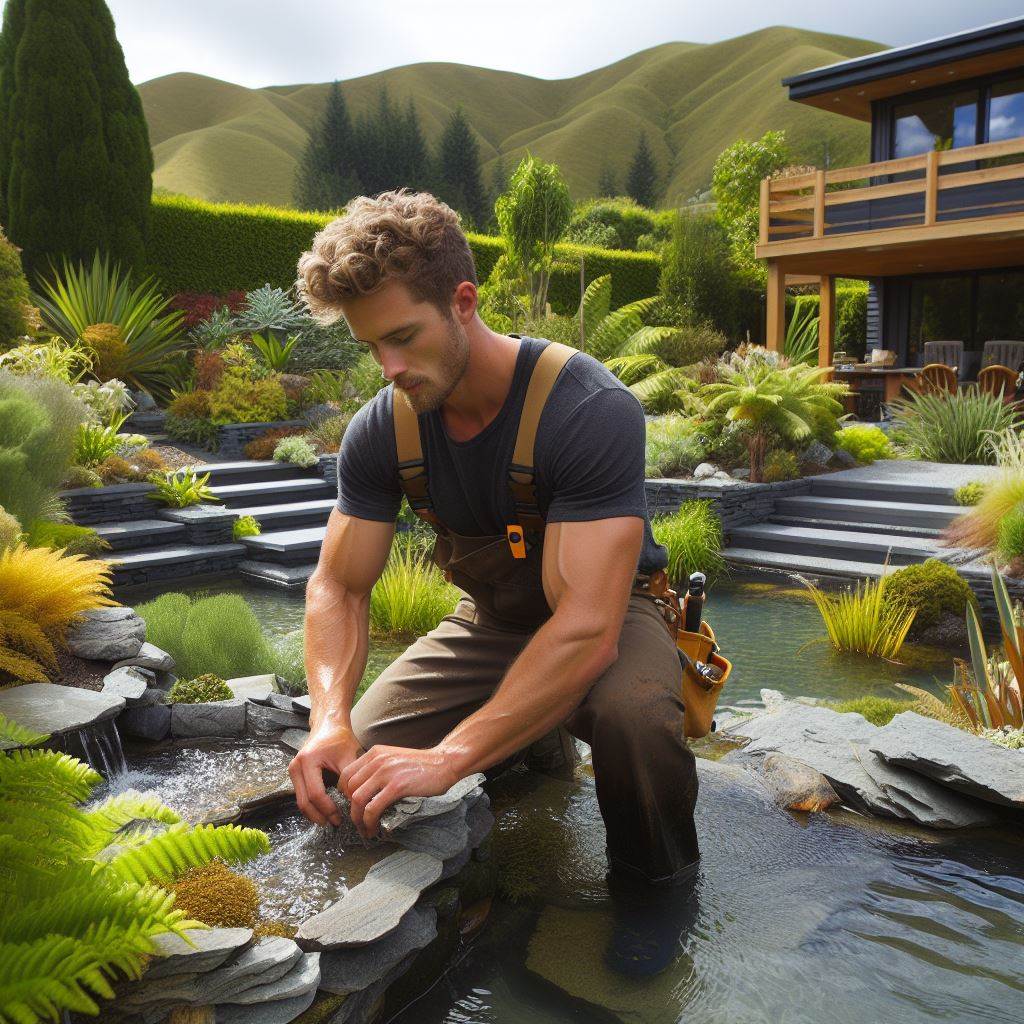Introduction
Water features, such as fountains and ponds, have become increasingly popular in New Zealand gardens.
Their appeal lies in their ability to add beauty and tranquility to outdoor spaces.
Beyond aesthetics, water features serve several valuable purposes.
They can attract wildlife, provide a cooling effect during hot summers, and mask unwanted noise.
In this blog section, we will explore various types of water features commonly found in New Zealand gardens and the benefits they bring.
From small bubbling fountains to grand cascading waterfalls, we will delve into how these features can transform a garden into a peaceful oasis.
We will discuss the importance of proper maintenance to ensure water clarity and prevent stagnation.
Additionally, we will provide tips on choosing the right location for a water feature and the necessary considerations, such as installation and potential safety hazards.
Join us as we explore the world of water features in New Zealand gardens, and discover the unique charm they bring to outdoor spaces.
Types of Water Features
Water features in New Zealand gardens offer captivating beauty and a serene ambiance.
Among the various options available, ponds, waterfalls, and fountains stand out as popular choices for enhancing garden landscapes.
Ponds
Ponds come in different sizes and shapes, creating diversity in garden design. They serve as habitats for aquatic plants and fish, promoting a healthy ecosystem.
To maintain a pond, regular maintenance tasks like removing debris, trimming plants, and checking water parameters are essential.
Waterfalls
Waterfalls add a dramatic element to garden designs. Cascading, tiered, and rock formations are common types.
The sound of flowing water and the visual appeal creates a relaxing atmosphere.
When installing a garden waterfall, considering the location, proper water circulation, and maintenance requirements are crucial.
Fountains
Fountains offer elegance and charm to garden landscapes.
There are various fountain styles to choose from, including tiered, wall-mounted, and free-standing options.
Apart from enhancing the aesthetic appeal, fountains also provide soothing sounds and can act as focal points in the garden.
When selecting a fountain, factors like size, material, and maintenance should be considered.
In summary, water features are an exquisite addition to New Zealand gardens.
Ponds, waterfalls, and fountains each have their unique advantages.
Ponds support aquatic life and require regular maintenance.
Waterfalls create a tranquil atmosphere and require proper installation and circulation.
Fountains add elegance and charm and should be chosen based on size, material, and maintenance.
Regardless of the choice, incorporating water features adds a touch of relaxation and beauty to any garden.
Read: Apprenticeships in Electrical Work: NZ Focus
Design and Placement Considerations
In the design and placement of water features in New Zealand gardens, several considerations must be taken into account.
This section will explore how water features can be integrated with the overall garden design and the importance of size, scale, safety, and maintenance.
Integration of water features with the overall garden design
To achieve a harmonious garden design, it is essential to integrate water features seamlessly with the surrounding environment.
The goal is to create a design where the water features blend naturally with the elements already present in the garden.
This can be achieved by selecting water features that complement the existing landscape, incorporating appropriate water plants, and using materials that harmonize with the overall garden theme.
In addition to blending in with the surroundings, water features can also be used as focal points or accents to enhance the visual appeal of the garden.
A well-placed fountain, pond, or waterfall can draw attention and create a sense of tranquility.
By carefully selecting the location and design of water features, they can become captivating features that add interest and charm to the garden.
Size and scale considerations for different types of water features
Choosing the right size of water feature is crucial for maintaining balance and visual appeal in the garden.
The water feature should be proportionate to the garden’s dimensions.
A small courtyard garden, for example, may be overwhelmed by a large, elaborate fountain.
On the other hand, a vast garden space would require a larger water feature to create a significant impact.
Proper sizing also involves considering the scale of other elements in the garden.
A tiny pond may appear insignificant when surrounded by towering trees, while a large pond may appear out of place in a small garden.
By carefully assessing the size and scale of both the water feature and the garden, a cohesive design can be achieved.
Safety measures and maintenance considerations
When incorporating water features into a garden, safety measures are of utmost importance.
Proper safety barriers, such as fencing or covers, should be installed to prevent accidents, especially in gardens frequented by children or pets.
Additionally, precautions should be taken to ensure that the water feature does not pose any risks, such as shallow areas that could be hazardous.
Maintenance is essential to keep water features in optimal condition and ensure their longevity.
Regular cleaning is necessary to prevent the buildup of algae and debris, which can affect the appearance and functionality of the water feature.
It is also important to check for leaks, maintain proper water circulation, and monitor the health of any aquatic plants or fish.
By implementing safety measures and following maintenance tips, water features can be enjoyed for years to come.
A well-designed and properly maintained water feature adds a touch of elegance, tranquility, and beauty to any garden.
Read: The Impact of Technology on NZ Electricians

NZ Native Water Feature Options
The unique water plants indigenous to New Zealand
- Pate: A popular native water plant with glossy leaves that provide shade and shelter for aquatic life.
- Raupo: This iconic plant is known for its tall, upright growth and string-like leaves.
- Tutu: A flowering native plant often found near water sources, adding color and vibrancy to water features.
- Kowhai: A small tree with vibrant yellow flowers that attract native birds, creating a lively atmosphere.
The benefits of using native species in water features
- Ecological balance: Native water plants help maintain a healthy ecosystem by providing food and habitats for local wildlife.
- Low maintenance: These plants are adapted to local conditions, requiring less care and reducing the need for chemicals.
- Biodiversity preservation: Incorporating native species in water features contributes to the conservation of New Zealand’s unique flora.
- Aesthetically pleasing: The natural beauty of native water plants adds a distinct charm to any garden or outdoor space.
Different options for incorporating NZ native water plants
- Floating plants: Species like pate and raupo can be placed in ponds, creating a floating carpet of greenery.
- Marginal plants: Tutu and kowhai can be planted along the edges of water features, enhancing their visual appeal.
- Waterfalls or streams: Native plants can be placed near flowing water to create a picturesque scene reminiscent of New Zealand’s landscapes.
- Cascading plants: Species like tutu can be strategically placed to cascade over rocks or feature walls for a dramatic effect.
Incorporating native water plants like pate, raupo, tutu, and kowhai enhances gardens with beauty and benefits.
These plants provide shade, shelter, and vibrant color, attracting wildlife and promoting ecological balance.
Raupo’s upright growth and stringy leaves add texture and interest to water features. Tutu’s blossoms attract pollinators and brighten surroundings.
Personalized Career Consulting
Unlock your potential with expert career advice tailored to your goals. Get personalized guidance and actionable steps toward your dream career in New Zealand.
Get StartedKowhai trees attract native birds, adding liveliness to gardens. Native plants require less maintenance and support local biodiversity.
Floating plants like pate and raupo create a lush carpet on water surfaces. Marginal plants like tutu and kowhai enhance edges.
Cascading plants like tutu add movement and drama to water features. Including native plants supports New Zealand’s biodiversity.
Read: Residential vs Commercial: NZ Electrician Roles
Inspiration and Ideas
Examples of stunning water features in NZ gardens
- The majestic waterfall in the Hamilton Gardens provides a breathtaking centerpiece to the landscape.
- The serene koi pond in the Pukeiti Rhododendron Trust garden creates a sense of tranquility.
- The contemporary water sculpture in the Ayrlies garden adds a modern touch.
- The natural rock pool in the Dunedin Chinese Garden blends harmoniously with its surroundings.
- The elegant water fountain in the Christchurch Botanic Gardens impresses visitors with its beauty.
Ideas for incorporating water features in different garden styles
- In a Japanese garden, consider adding a traditional stone basin (tsukubai) as a focal point.
- For a tropical garden, install a cascading waterfall surrounded by lush foliage.
- In a minimalist garden, a simple reflecting pool with clean lines can create a sense of calmness.
- A formal garden can benefit from a classic tiered fountain as a striking centerpiece.
- In a cottage garden, a whimsical and rustic water mill can add charm and character.
Sources of inspiration for creative water feature designs
- Look to historical gardens, such as the Italian Renaissance gardens, for timeless water feature ideas.
- Explore architectural magazines and websites to find innovative water feature designs.
- Visit local garden shows and exhibitions to see unique and cutting-edge water feature installations.
- Consult with a landscape designer who specializes in water features for expert advice and inspiration.
- Experiment with different materials, such as stainless steel or glass, to create a contemporary water feature.
Overall, there is no shortage of inspiration when it comes to water features in NZ gardens.
Whether you prefer a traditional look or a modern design, incorporating a water feature can add beauty, tranquility, and a sense of wonder to your garden.
By showcasing stunning examples, providing ideas for different garden styles, and exploring additional sources of inspiration, you can create a truly captivating water feature that enhances your outdoor space.
Read: Women in Electrical Trades: NZ’s Growing Trend
Conclusion
In closing, we’ve explored the beauty and benefits of incorporating native water plants into New Zealand gardens.
These plants, including pate, raupo, tutu, and kowhai, offer shade, shelter, vibrant colors, and attract wildlife, enriching the ecological balance of our outdoor spaces.
Water features not only enhance the aesthetic appeal of gardens but also support the country’s unique biodiversity.
They provide habitats for native flora and fauna, contributing to a thriving ecosystem.
I encourage you to embrace the opportunity to experiment with water features in your own garden.
Whether it’s incorporating floating plants like pate and raupo, or adding cascading plants like tutu, there are endless possibilities to create a stunning oasis while contributing to the preservation of New Zealand’s natural heritage.
Let’s explore and celebrate the wonders of water features in our gardens!




